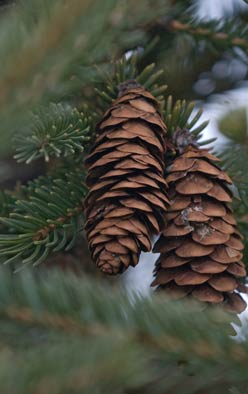How to Care for Your Farm-Grown Fresh Christmas Tree
When a Christmas tree is cut, over half of its weight is water. With proper care, you can maintain the quality of your displayed trees. Below are a number of tips relating to the care of displayed trees:
- Displaying trees in water in a traditional reservoir type stand is the most effective way of maintaining their freshness and minimizing needle loss problems.
 Make a fresh cut to remove about a 1/2-inch thick disk of wood from the base of the trunk before putting the tree in the stand. Make the cut perpendicular to the stem axis. Don't cut the trunk at an angle, or into a v-shape, which makes it far more difficult to hold the tree in the stand and also reduces the amount of water available to the tree.
Make a fresh cut to remove about a 1/2-inch thick disk of wood from the base of the trunk before putting the tree in the stand. Make the cut perpendicular to the stem axis. Don't cut the trunk at an angle, or into a v-shape, which makes it far more difficult to hold the tree in the stand and also reduces the amount of water available to the tree.- Once home, place the tree in water as soon as possible. Most species can go 6 to 8 hours after cutting the trunk and still take up water. Don't bruise the cut surface or get it dirty.
- If needed, trees can be temporarily stored for several days in a cool location. Place the freshly cut trunk in a bucket that is kept full of water.
- To display the trees indoors, use a stand with an adequate water holding capacity for the tree. As a general rule, stands should provide 1 quart of water per inch of stem diameter. Devices are available that help maintain a constant water level in the stand.
- Use a stand that fits your tree. Avoid whittling the sides of the trunk down to fit a stand. The outer layers of wood are the most efficient in taking up water and should not be removed.
- Keep displayed trees away from sources of heat (fireplaces, heaters, heat vents, direct sunlight). Lowering the room temperature will slow the drying process, resulting in less water consumption each day.
- The temperature of the water used to fill the stand is not important and does not affect water uptake.
- Check the stand daily to make sure that the level of water does not go below the base of the tree. With many stands, there can still be water in the stand even though the base of the tree is no longer submerged in water.
- Drilling a hole in the base of the trunk does not improve water uptake.
- Use of lights that produce low heat, such as miniature lights, will reduce drying of the tree.
- Always inspect light sets prior to placing them on the tree. If worn, replace with a new set.
- Do not overload electrical circuits.
- Always turn off the tree lights when leaving the house or when going to bed.
- Monitor the tree for freshness. After Christmas or if the tree is dry, remove it from the house.
- Go to www.realchristmastrees.org and type in your ZIP code to find a recycling program near you.
- Never burn any part of a Christmas tree in a wood stove or fireplace.
Prepared by Dr. Gary Chastagner and Dr. Eric Hinesley
Edited by the Scientific Research Committee of the National Christmas Tree Association
Download a printable version of these tree care tips:
- English version
- Spanish version: Cómo cuidar de su árbol de Navidad natural cultivado y fresco
If you get a tree with roots attached, either in a pot or burlap, please read these suggestions:
- The adaptability of the species should be considered. Many species are shipped outside of their natural area and may not be adaptable to other areas. Check with a reliable nursery or extension forester.
- Keep in mind that Living Trees are VERY heavy and bulky. A six foot tall balled and burlapped tree will weigh as much as 250 pounds.
- The tree should be stored in an unheated, sheltered area such as a garage or porch, out of the wind and sun. Do not expose the tree to freezing temperatures at any time.
- The tree will need adequate water. The root ball or soil should be kept slightly damp but not flooded. Wrap the root ball of a balled tree in plastic or place in a tub while it is in the house.
- Live trees may be decorated, but with care. If lights are used, they must not give off any heat.
- Do not remove the tree directly from a warm house out into freezing temperatures. Instead, move to a sheltered area first for several days.
- If the ground is unfrozen, the tree may be replanted. The spot to be dug should be mulched to prevent freezing. Plant as soon as possible.
- Do not remove the burlap and strapping (unless it is plastic). This keeps the root ball solid and secure. In the instance of a plastic cover, cut the cord and roll down the plastic at least half way prior to planting. Tap the tree container of a potted tree and remove prior to planting. Do not attempt to remove soil from the root system. Earth removed from the original hole should be backfilled around the root ball. Mulch heavily over the top of the planted root ball to prevent it from freezing. Water only as needed: a flooded tree may not survive.
- Stake the trees to prevent wind tipping or damage during the first growing season.
